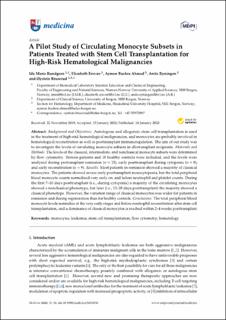| dc.contributor.author | Rundgren, Ida Marie | |
| dc.contributor.author | Ersvær, Elisabeth | |
| dc.contributor.author | Ahmed, Aymen B | |
| dc.contributor.author | Bruserud, Øystein | |
| dc.coverage.spatial | Norway | en_US |
| dc.date.accessioned | 2020-04-24T06:00:41Z | |
| dc.date.available | 2020-04-24T06:00:41Z | |
| dc.date.created | 2020-01-31T12:08:15Z | |
| dc.date.issued | 2020 | |
| dc.identifier.citation | Rundgren, I. M., Ersvær, E., Ahmed, A. B., Ryningen, A., & Bruserud, Ø. (2020). A pilot study of circulating monocyte subsets in patients treated with stem cell transplantation for high-risk hematological malignancies. Medicina, 56(1). | en_US |
| dc.identifier.issn | 1010-660X | |
| dc.identifier.uri | https://hdl.handle.net/11250/2652279 | |
| dc.description.abstract | Background and Objectives: Autologous and allogeneic stem cell transplantation is used in the treatment of high-risk hematological malignancies, and monocytes are probably involved in hematological reconstitution as well as posttransplant immunoregulation. The aim of our study was to investigate the levels of circulating monocyte subsets in allotransplant recipients. Materials and Methods: The levels of the classical, intermediate, and nonclassical monocyte subsets were determined by flow cytometry. Sixteen patients and 18 healthy controls were included, and the levels were analyzed during pretransplant remission (n = 13), early posttransplant during cytopenia (n = 9), and early reconstitution (n = 9). Results: Most patients in remission showed a majority of classical monocytes. The patients showed severe early posttransplant monocytopenia, but the total peripheral blood monocyte counts normalized very early on, and before neutrophil and platelet counts. During the first 7–10 days posttransplant (i.e., during cytopenia) a majority of the circulating monocytes showed a nonclassical phenotype, but later (i.e., 12–28 days posttransplant) the majority showed a classical phenotype. However, the variation range of classical monocytes was wider for patients in remission and during regeneration than for healthy controls. Conclusions: The total peripheral blood monocyte levels normalize at the very early stages and before neutrophil reconstitution after stem cell transplantation, and a dominance of classical monocytes is reached within 2–4 weeks posttransplant. | en_US |
| dc.language.iso | eng | en_US |
| dc.publisher | MDPI | en_US |
| dc.rights | Navngivelse 4.0 Internasjonal | * |
| dc.rights.uri | http://creativecommons.org/licenses/by/4.0/deed.no | * |
| dc.subject | monocytes | en_US |
| dc.subject | leukemia | en_US |
| dc.subject | stem cell transplantation | en_US |
| dc.subject | flow cytometry | en_US |
| dc.subject | hematology | en_US |
| dc.title | A Pilot Study of Circulating Monocyte Subsets in Patients Treated with Stem Cell Transplantation for High-Risk Hematological Malignancies. | en_US |
| dc.type | Peer reviewed | en_US |
| dc.type | Journal article | en_US |
| dc.description.version | publishedVersion | en_US |
| dc.rights.holder | © 2020 by the authors | en_US |
| dc.subject.nsi | VDP::Medisinske Fag: 700::Klinisk medisinske fag: 750::Onkologi: 762 | en_US |
| dc.source.volume | 56 | en_US |
| dc.source.journal | Medicina (Kaunas) | en_US |
| dc.source.issue | 1 | en_US |
| dc.identifier.doi | 10.3390/medicina56010036 | |
| dc.identifier.cristin | 1788003 | |
| dc.relation.project | Kreftforeningen: 100933 | en_US |
| dc.relation.project | Kreftforeningen: 182609 | en_US |
| dc.relation.project | Helse Vest: 911946 | en_US |
| dc.relation.project | Helse Vest: 912051 | en_US |
| dc.relation.project | Helse Vest: 912178 | en_US |
| cristin.ispublished | true | |
| cristin.fulltext | original | |
| cristin.qualitycode | 1 | |

